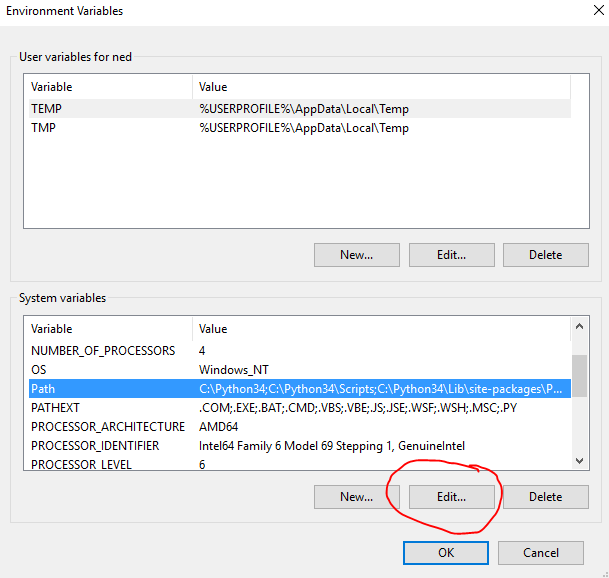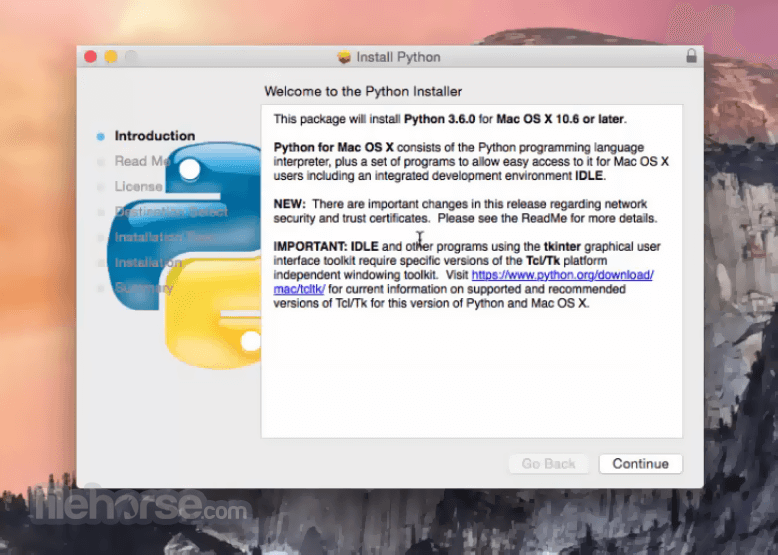- Python 3 Download Mac Os Mojave
- Python 3 Download Mac Os Catalina
- Python 3 For Mac
- Python 3 Download Mac Os Virtualbox
More from Raghav - How to install Python on MacOS Step by Step for Beginners Today we will learn: 1. Check if Python is alr.
Bob Savage <bobsavage@mac.com>
Python 3 Download Mac Os Mojave
Python on a Macintosh running Mac OS X is in principle very similar to Python onany other Unix platform, but there are a number of additional features such asthe IDE and the Package Manager that are worth pointing out.
4.1. Getting and Installing MacPython¶
- May 11, 2017 Apple’s Mac OS comes with python 2.7 installed by default. Perhaps you may want to use python 3.x.x on your machine and also use pip for package management with python 3.x.x. The easiest way to achieve this is by: NOTE: This tutorial does not use Virtual Environments like virtualenv or pyenv to manage various python versions.
- Release Date: May 13, 2020. This is the third maintenance release of Python 3.8. The Python 3.8 series is the newest major release of the Python programming language, and it contains many new features and optimizations. Major new features of the 3.8 series, compared to 3.7. PEP 572, Assignment expressions; PEP 570, Positional-only.
- Currently, he develops software for the financial services industry and leads classes and workshops in Python at PracticalProgramming.co Python Fundamentals Live Stream Python fundamentals is an interactive 1.5-hour live python programming webinar for beginners.
Mac OS X 10.8 comes with Python 2.7 pre-installed by Apple. If you wish, youare invited to install the most recent version of Python 3 from the Pythonwebsite (https://www.python.org). A current “universal binary” build of Python,which runs natively on the Mac’s new Intel and legacy PPC CPU’s, is availablethere.
What you get after installing is a number of things:
A
Python3.8folder in yourApplicationsfolder. In hereyou find IDLE, the development environment that is a standard part of officialPython distributions; and PythonLauncher, which handles double-clicking Pythonscripts from the Finder.A framework
/Library/Frameworks/Python.framework, which includes thePython executable and libraries. The installer adds this location to your shellpath. To uninstall MacPython, you can simply remove these three things. Asymlink to the Python executable is placed in /usr/local/bin/.
The Apple-provided build of Python is installed in/System/Library/Frameworks/Python.framework and /usr/bin/python,respectively. You should never modify or delete these, as they areApple-controlled and are used by Apple- or third-party software. Remember thatif you choose to install a newer Python version from python.org, you will havetwo different but functional Python installations on your computer, so it willbe important that your paths and usages are consistent with what you want to do.
IDLE includes a help menu that allows you to access Python documentation. If youare completely new to Python you should start reading the tutorial introductionin that document.
If you are familiar with Python on other Unix platforms you should read thesection on running Python scripts from the Unix shell.
4.1.1. How to run a Python script¶
Your best way to get started with Python on Mac OS X is through the IDLEintegrated development environment, see section The IDE and use the Help menuwhen the IDE is running.
If you want to run Python scripts from the Terminal window command line or fromthe Finder you first need an editor to create your script. Mac OS X comes with anumber of standard Unix command line editors, vim andemacs among them. If you want a more Mac-like editor,BBEdit or TextWrangler from Bare Bones Software (seehttp://www.barebones.com/products/bbedit/index.html) are good choices, as isTextMate (see https://macromates.com/). Other editors includeGvim (http://macvim-dev.github.io/macvim/) and Aquamacs(http://aquamacs.org/).
To run your script from the Terminal window you must make sure that/usr/local/bin is in your shell search path.

To run your script from the Finder you have two options:
Drag it to PythonLauncher
Select PythonLauncher as the default application to open yourscript (or any .py script) through the finder Info window and double-click it.PythonLauncher has various preferences to control how your script islaunched. Option-dragging allows you to change these for one invocation, or useits Preferences menu to change things globally.
4.1.2. Running scripts with a GUI¶
With older versions of Python, there is one Mac OS X quirk that you need to beaware of: programs that talk to the Aqua window manager (in other words,anything that has a GUI) need to be run in a special way. Use pythonwinstead of python to start such scripts.
With Python 3.8, you can use either python or pythonw.
4.1.3. Configuration¶
Python on OS X honors all standard Unix environment variables such asPYTHONPATH, but setting these variables for programs started from theFinder is non-standard as the Finder does not read your .profile or.cshrc at startup. You need to create a file~/.MacOSX/environment.plist. See Apple’s Technical Document QA1067 fordetails.
For more information on installation Python packages in MacPython, see sectionInstalling Additional Python Packages.
4.2. The IDE¶
MacPython ships with the standard IDLE development environment. A goodintroduction to using IDLE can be found athttp://www.hashcollision.org/hkn/python/idle_intro/index.html.
4.3. Installing Additional Python Packages¶
There are several methods to install additional Python packages:

Packages can be installed via the standard Python distutils mode (
pythonsetup.pyinstall).Many packages can also be installed via the setuptools extensionor pip wrapper, see https://pip.pypa.io/.
4.4. GUI Programming on the Mac¶
There are several options for building GUI applications on the Mac with Python.
PyObjC is a Python binding to Apple’s Objective-C/Cocoa framework, which isthe foundation of most modern Mac development. Information on PyObjC isavailable from https://pypi.org/project/pyobjc/.
The standard Python GUI toolkit is tkinter, based on the cross-platformTk toolkit (https://www.tcl.tk). An Aqua-native version of Tk is bundled with OSX by Apple, and the latest version can be downloaded and installed fromhttps://www.activestate.com; it can also be built from source.
wxPython is another popular cross-platform GUI toolkit that runs natively onMac OS X. Packages and documentation are available from https://www.wxpython.org.
PyQt is another popular cross-platform GUI toolkit that runs natively on MacOS X. More information can be found athttps://riverbankcomputing.com/software/pyqt/intro.
4.5. Distributing Python Applications on the Mac¶
The standard tool for deploying standalone Python applications on the Mac ispy2app. More information on installing and using py2app can be foundat http://undefined.org/python/#py2app.
4.6. Other Resources¶
The MacPython mailing list is an excellent support resource for Python users anddevelopers on the Mac:
Another useful resource is the MacPython wiki:
Active Python Releases
For more information visit the Python Developer's Guide.
- 3.8bugfix2019-10-142024-10PEP 569
- 3.7security2018-06-272023-06-27PEP 537
- 3.6security2016-12-232021-12-23PEP 494
- 3.5end-of-life2015-09-132020-09-05PEP 478
- 2.7end-of-life2010-07-032020-01-01PEP 373
Looking for a specific release?

Python releases by version number:
- Python 2.7.8July 2, 2014 DownloadRelease Notes
- Python 2.7.7June 1, 2014 DownloadRelease Notes
- Python 3.4.1May 19, 2014 DownloadRelease Notes
- Python 3.4.0March 17, 2014 DownloadRelease Notes
- Python 3.3.5March 9, 2014 DownloadRelease Notes
- Python 3.3.4Feb. 9, 2014 DownloadRelease Notes
- Python 3.3.3Nov. 17, 2013 DownloadRelease Notes
- Python 2.7.6Nov. 10, 2013 DownloadRelease Notes
- Python 2.6.9Oct. 29, 2013 DownloadRelease Notes
- Python 3.3.2May 15, 2013 DownloadRelease Notes
- Python 3.2.5May 15, 2013 DownloadRelease Notes
- Python 2.7.5May 12, 2013 DownloadRelease Notes
- Python 3.3.1April 6, 2013 DownloadRelease Notes
- Python 3.2.4April 6, 2013 DownloadRelease Notes
- Python 2.7.4April 6, 2013 DownloadRelease Notes
- Python 3.3.0Sept. 29, 2012 DownloadRelease Notes
- Python 3.2.3April 10, 2012 DownloadRelease Notes
- Python 2.6.8April 10, 2012 DownloadRelease Notes
- Python 3.1.5April 9, 2012 DownloadRelease Notes
- Python 2.7.3April 9, 2012 DownloadRelease Notes
- Python 3.2.2Sept. 3, 2011 DownloadRelease Notes
- Python 3.2.1July 9, 2011 DownloadRelease Notes
- Python 2.7.2June 11, 2011 DownloadRelease Notes
- Python 3.1.4June 11, 2011 DownloadRelease Notes
- Python 2.6.7June 3, 2011 DownloadRelease Notes
- Python 2.5.6May 26, 2011 DownloadRelease Notes
- Python 3.2.0Feb. 20, 2011 DownloadRelease Notes
- Python 2.7.1Nov. 27, 2010 DownloadRelease Notes
- Python 3.1.3Nov. 27, 2010 DownloadRelease Notes
- Python 2.6.6Aug. 24, 2010 DownloadRelease Notes
- Python 2.7.0July 3, 2010 DownloadRelease Notes
- Python 3.1.2March 20, 2010 DownloadRelease Notes
- Python 2.6.5March 18, 2010 DownloadRelease Notes
- Python 2.5.5Jan. 31, 2010 DownloadRelease Notes
- Python 2.6.4Oct. 26, 2009 DownloadRelease Notes
- Python 2.6.3Oct. 2, 2009 DownloadRelease Notes
- Python 3.1.1Aug. 17, 2009 DownloadRelease Notes
- Python 3.1.0June 26, 2009 DownloadRelease Notes
- Python 2.6.2April 14, 2009 DownloadRelease Notes
- Python 3.0.1Feb. 13, 2009 DownloadRelease Notes
- Python 2.5.4Dec. 23, 2008 DownloadRelease Notes
- Python 2.4.6Dec. 19, 2008 DownloadRelease Notes
- Python 2.5.3Dec. 19, 2008 DownloadRelease Notes
- Python 2.6.1Dec. 4, 2008 DownloadRelease Notes
- Python 3.0.0Dec. 3, 2008 DownloadRelease Notes
- Python 2.6.0Oct. 2, 2008 DownloadRelease Notes
- Python 2.3.7March 11, 2008 DownloadRelease Notes
- Python 2.4.5March 11, 2008 DownloadRelease Notes
- Python 2.5.2Feb. 21, 2008 DownloadRelease Notes
- Python 2.5.1April 19, 2007 DownloadRelease Notes
- Python 2.3.6Nov. 1, 2006 DownloadRelease Notes
- Python 2.4.4Oct. 18, 2006 DownloadRelease Notes
- Python 2.5.0Sept. 19, 2006 DownloadRelease Notes
- Python 2.4.3April 15, 2006 DownloadRelease Notes
- Python 2.4.2Sept. 27, 2005 DownloadRelease Notes
- Python 2.4.1March 30, 2005 DownloadRelease Notes
- Python 2.3.5Feb. 8, 2005 DownloadRelease Notes
- Python 2.4.0Nov. 30, 2004 DownloadRelease Notes
- Python 2.3.4May 27, 2004 DownloadRelease Notes
- Python 2.3.3Dec. 19, 2003 DownloadRelease Notes
- Python 2.3.2Oct. 3, 2003 DownloadRelease Notes
- Python 2.3.1Sept. 23, 2003 DownloadRelease Notes
- Python 2.3.0July 29, 2003 DownloadRelease Notes
- Python 2.2.3May 30, 2003 DownloadRelease Notes
- Python 2.2.2Oct. 14, 2002 DownloadRelease Notes
- Python 2.2.1April 10, 2002 DownloadRelease Notes
- Python 2.1.3April 9, 2002 DownloadRelease Notes
- Python 2.2.0Dec. 21, 2001 DownloadRelease Notes
- Python 2.0.1June 22, 2001 DownloadRelease Notes
View older releases
Licenses
All Python releases are Open Source. Historically, most, but not all, Python releases have also been GPL-compatible. The Licenses page details GPL-compatibility and Terms and Conditions.
Sources
For most Unix systems, you must download and compile the source code. The same source code archive can also be used to build the Windows and Mac versions, and is the starting point for ports to all other platforms.
Download the latest Python 3 and Python 2 source.
Python 3 Download Mac Os Catalina
Alternative Implementations
This site hosts the 'traditional' implementation of Python (nicknamed CPython). A number of alternative implementations are available as well.
History
Python 3 For Mac
Python was created in the early 1990s by Guido van Rossum at Stichting Mathematisch Centrum in the Netherlands as a successor of a language called ABC. Guido remains Python’s principal author, although it includes many contributions from others.
Python 3 Download Mac Os Virtualbox
Looking for the release schedule? Check the Google Calendar.